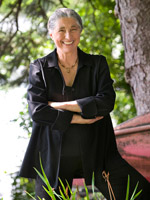Poems by Carolyn North
Archives: by Issue | by Author Name

photo by Susan Wilson
Musings from the Silence at the Vedanta Retreat in Olema, California.
What's a Weed?
by Carolyn North
From Canary Spring 2014
Carolyn lives between the Derby and Temescal watersheds on the east side of San Francisco Bay.

The word “weed” generally refers to a plant not valued for use or beauty, that grows wild and rank and hinders the growth of superior vegetation. One dictionary defines weed as an “unprofitable, troublesome, or noxious growth, a plant considered to be a nuisance. The word commonly is applied to unwanted plants in human-controlled settings or any plants that grow and reproduce aggressively and invasively.” In other words, a plant smart enough to know how to survive no matter what, that takes advantage of whatever the world offers it to live.
I’ve been weeding in the Vedanta garden, often wondering what to pull and what to keep. The roses and azaleas I know are keepers, and the iris, just past, and the lavender bushes. The intruding grasses have got to go, but just a few yards away in the meadow they are native, at home, welcome. Poppies as well, although once they invade the cultivated beds they make themselves quite at home because, well, they are at home. This is their turf, as it is for plantain and clover, mullein and dandelion. I grab a handful of bindweed, amazed by its tenacity and the range of its roots, and I find myself mentally apologizing to it when I toss it onto the dead pile.
I want to applaud all these weeds for their cleverness in snuggling up close to the cultivars, the “superior vegetation” that receives regular watering, where they can, for awhile at least, mask themselves and drink their fill. At least until some human with an attitude – like me, for example – comes along and yanks them out.
It’s true, though, that the stunning show of the exotics’ white and bright red, deep purple and orange against the greens of the garden shows the glory of flowers more vividly than the subtle shades of the dry dirt natives, but who is likely to survive when the water and the weeders run out? Given a season or two of non-interference, which plants are likely to still be here, providing medicine for the soil and whatever humans are still around, and which plants will have dropped their leaves in a last, sad hurrah? (Plaintain: skin abrasions, laxative. Clover: antispasmodic, anticoagulent, diuretic. Mullein: sedative, anti-inflammatory. Dandelion: liver tonic, diuretic...)
So who decides what gets to stay and what must go, and by what criteria do we/they make our call? The big-time weeders cut down whole forests and shoot wolves from helicopters. Bears are almost gone and puffins have gone extinct. The local cops even shot a coyote who wandered into my town one night, probably disoriented, and I’m told that once eagles flew in these skies. Maybe we are the weeds, the noxious intruders who have reproduced aggressively and invasively, hindering the growth of a superior and diverse community?
Personally, I consider us humans rather gorgeous and remarkable additions to the world scene, but still in an infantile stage that doesn’t yet know when it’s OK to interfere with the natural order and when it’s simply stupid to do so. What ignorance about how it all goes together – or even that it all goes together! What will it take for us to learn to keep our hands to ourselves and our eyes and ears humbly open?
Balance. It’s all about keeping in balance with the world and the others here with us, becoming neither weeds nor weed pullers, but equal members of the whole enchilada, benefiting and being benefited in turn. What made us ever think otherwise?
© Carolyn North